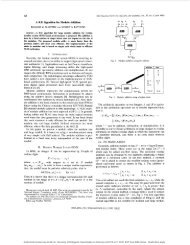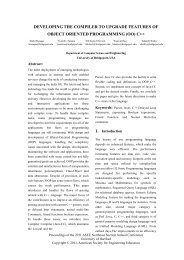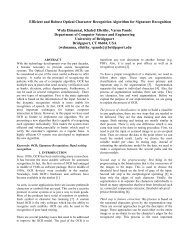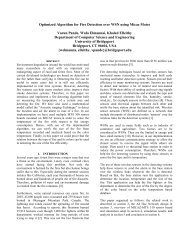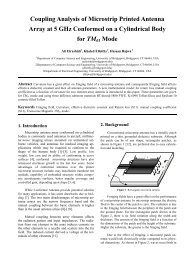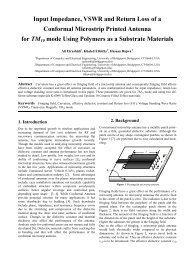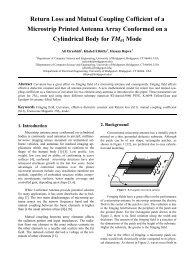Steganography in Arabic Text Using Kashida ... - ResearchGate
Steganography in Arabic Text Using Kashida ... - ResearchGate
Steganography in Arabic Text Using Kashida ... - ResearchGate
You also want an ePaper? Increase the reach of your titles
YUMPU automatically turns print PDFs into web optimized ePapers that Google loves.
Case 0: call Scenario_0(Block I); Break;<br />
Case 1: call Scenario_1(Block I); Break;<br />
Case 2: call Scenario_2(Block I); Break;<br />
Case 3: call Scenario_3(Block I); Break;<br />
}<br />
Insert encrypted (Block I) to Stego message<br />
Next I<br />
Output Stego message<br />
Rout<strong>in</strong>e Scenario_0(Block I) // Add<strong>in</strong>g <strong>Kashida</strong> after po<strong>in</strong>ted<br />
letters to encode one, otherwise, zero.<br />
While Not_End_Block<br />
Read letter<br />
If letter connected then // we can add <strong>Kashida</strong><br />
{<br />
If (Hide bit==1) then<br />
Add <strong>Kashida</strong><br />
Replace (Letter)<br />
Else<br />
No_change<br />
}<br />
Next Letter<br />
End while<br />
End Rout<strong>in</strong>e Scenario_0<br />
a word. This is while other algorithms such as [9] can pass<br />
only one bit per word.<br />
I. Our algorithm can be applied <strong>in</strong> different file formats like<br />
HTML files, and MS word files. This will also will reduce<br />
<strong>in</strong>truder suspicions.<br />
II.<br />
III.<br />
Another advantage is that there is no need to create a<br />
database dictionary like [15] where search<strong>in</strong>g for<br />
synonyms words will consume some time, and may give<br />
<strong>in</strong>truders a chance to analyze the transmitted files.<br />
Randomization of our algorithm will improve robustness of<br />
hidden data, s<strong>in</strong>ce <strong>in</strong> each round, the algorithm will pack<br />
up one of four states and this will prevent the <strong>in</strong>truder to<br />
figure out the algorithm procedure.<br />
IV. Our algorithm can be extended to other similar Unicode<br />
languages like Urdu, Pashto, and Persian. Moreover our<br />
algorithm can be widely used, as Urdu and <strong>Arabic</strong><br />
represent the 3 rd and 4 th top languages population [21].<br />
V. By employ<strong>in</strong>g <strong>Kashida</strong> variation algorithm, unlike [9] the<br />
text semantic will not be changed.<br />
Figure 3. Message segmentation and aggregation<br />
IV.<br />
ALGORITHM ANALYSIS AND ADVANTAGES<br />
In our algorithm, we used variation and randomization to<br />
improve <strong>Kashida</strong> algorithm to hide data <strong>in</strong>side Unicode<br />
(<strong>Arabic</strong> language). In the follow<strong>in</strong>g section, we explore and<br />
analytically discuss some of the advantages of the proposed<br />
algorithm.<br />
Hid<strong>in</strong>g capacity, transparency, and robustness represent the<br />
most important goals for any <strong>Steganography</strong> algorithm. In our<br />
algorithm, we achieve the follow<strong>in</strong>g advantages:-By us<strong>in</strong>g the<br />
<strong>Kashida</strong> variation algorithm, we can pass more than one bit for<br />
Figure 4.Rout<strong>in</strong>e Scenario_0 flow chart<br />
V. EXPERIMENTS AND RESULTS<br />
In this section, we explore some of the results acquired by<br />
apply<strong>in</strong>g our algorithm and consider<strong>in</strong>g the concept of hidden<br />
ratio.<br />
Hidden ratio is def<strong>in</strong>ed as:<br />
Hidden Ratio=amount of hidden data/carrier file size (1)



